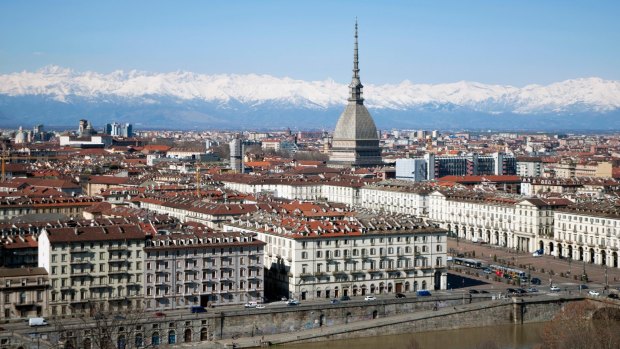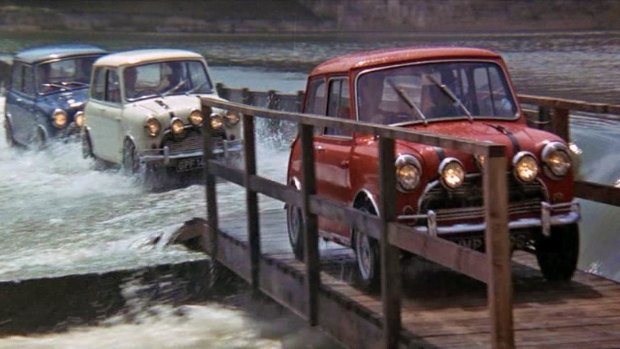This was published 7 years ago
The National Cinema Museum: Fans of Italian cinema will love Turin's tribute to film history
By Daniel Scott

Piazza Vittorio Veneto and Mole Antonelliana, Turin, Piedmont.Credit: Alamy
Think of Italy and movies and the credits roll with a litany of unforgettable film titles such as La Dolce Vita, Cinema Paradiso and Life is Beautiful; of distinguished directors Fellini, Zeffierelli and Rossellini and larger-than-life screen actors Sophia Loren, Roberto Benigni and Isabella Rossellini (daughter of the director and Ingrid Bergman).
The Italian landscape also rushes to mind, appearing like the biggest star of them all. There's Rome in La Dolce Vita, the Amalfi Coast in The Talented Mr Ripley and Tuscany in any number of movies including A Room with a View and Tea with Mussolini.
But for any male of a certain vintage, there is one 1969 movie, starring Michael Caine as a Cockney bank robber, and improbably Noel Coward and comedian Benny Hill as well, which will forever remain with us thanks to its car chase scenes set in the northern Italian city of Turin.

A scene from from the 1969 classic movie, The Italian Job.
The Italian Job brought us three bullion-loaded Mini Coopers pelting down the steps of the Gran Madre di Dio church during a wedding, screeching around grid-locked Turin traffic, tearing through its pedestrianised, colonnaded gallerias and even crashing along a weir on the Po river, which dissects the city.
Visiting Turin almost 40 years later, at either end of an eight-day trek through the Piedmont hills, it's those scenes that animate my perspective. It's hard to sit placidly outside a cafe in the Galleria San Frederico, adjacent to the central Piazza San Carlo, without expecting an imminent onrush of Minis.
Yet, ironically, if there is one place in Turin in which such images desist, it is at the National Cinema Museum, fading even on the approach to the building in which it is housed, the Mole di Antonelliana.
Built in 1889 as a symbol of recently established Italian unity, the Mole is as distinctive an edifice as any in Turin. Originally conceived as a synagogue, it rises 167 metres into the city skyline, its four-faced dome and needle-like summit a prominent landmark. With its colonnaded facades and that helmet-like dome, it has a military, fortified presence. It also makes claim to being the world's tallest museum.
What's inside, created by Swiss set designer Francois Confino for the museum opening in the Mole Antonielliana in 2000, is a panoply of cinema history, from its origins in shadow theatre and magic lanterns to the present day, with its 3D and other special effects.
The exhibits are based on the extensive collections of cinema historian Maria Adriana Prolo, which she began in 1941.
At once inviting and glamorous, the museum unfolds around a central Temple Hall, in which reclining chairs are angled toward screens and exhibition areas depicting various genres such as Italian post-war Neorealist cinema, including greats The Bicycle Thieves and La Strada.
Other "chapels" surrounding the central hall include reconstructed movie sets and displays dedicated to genres including westerns, musicals, animated films, horror and fantasy. One side-exhibit contains a love-heart shaped bed on which you can lie down and watch movie clips.
The designer's most striking use of the unusual interior is in the Heliocoidal ramp which unfurls up the building's sides, rising over several levels to its dome.
"One can't imagine," said Contino at the time, "a Cinema Museum as just a museum of objects and machines because the essence of cinema is film."
Off the coiling ramp are further ante-rooms exhibiting the apparatus of cinema and along its walls are original notices from Italian cinema's golden era, each accompanied by detailed descriptions of the films and how they were made.
Passing melodramatic posters for films like Stromboli, set in the shadow of the island volcano, directed by Rossellini and starring Ingrid Bergman, it is impossible not to be plunged headlong into the grainy filmic world of postwar Italy.
While it pulls hard at the nostalgic heart strings, the cinema museum also feels cutting edge, with sound and light shows projected onto the cupola and a transparent lift shooting up through its midst to a panoramic viewing platform, at 85 meters, from which you can see across Turin to the Alps.
Completing the Cinema Museum experience is a stylish cafe/restaurant and an onsite shop where it's tempting to invest in several replica movie posters to bring a touch of Italian neorealism to the walls back home.
TRIP NOTES
MORE INFORMATION
GETTING THERE
British Airways flies daily from Sydney to London Heathrow, with connections to Turin from Gatwick. BA.com.
TOURING THERE
The National Cinema Museum is at Mole Antonelliana, Via Montebeloo 20, Turin. Open Wednesday-Monday 9am-8pm (11pm Saturday). Museum admission and the Panoramic Lift is €14 ($20) or the museum only, €10; see cinemamuseo.it
Hidden Italy's Piedmont self-guided walking tour starts at $1850 a person, including transfers to and from Turin, seven nights' accommodation and daily baggage transfer; see hiddenitaly.com.au.
Daniel Scott travelled with assistance from Hidden Italy
Sign up for the Traveller Deals newsletter
Get exclusive travel deals delivered straight to your inbox. Sign up now.